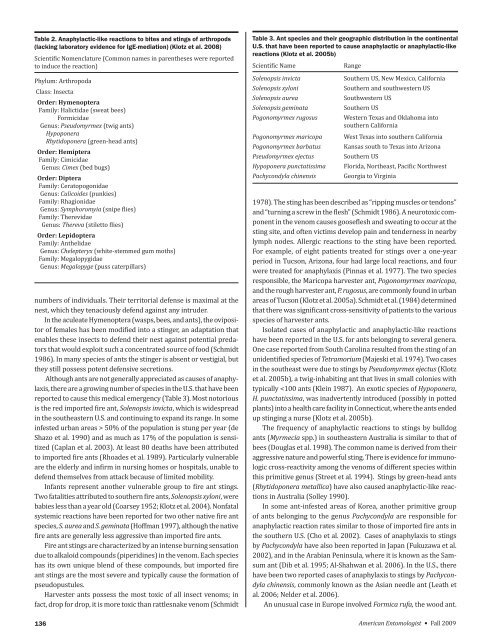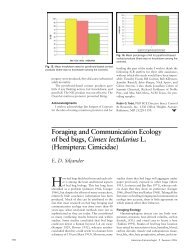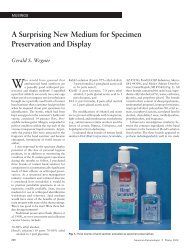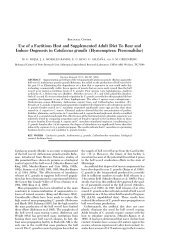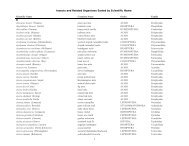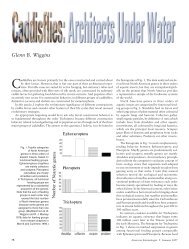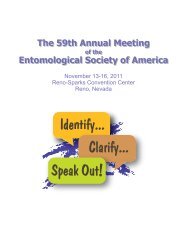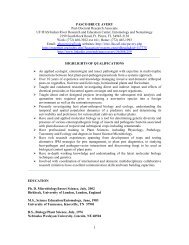to Arthropod Bites and Stings - Entomological Society of America
to Arthropod Bites and Stings - Entomological Society of America
to Arthropod Bites and Stings - Entomological Society of America
You also want an ePaper? Increase the reach of your titles
YUMPU automatically turns print PDFs into web optimized ePapers that Google loves.
Table 2. Anaphylactic-like reactions <strong>to</strong> bites <strong>and</strong> stings <strong>of</strong> arthropods<br />
(lacking labora<strong>to</strong>ry evidence for IgE-mediation) (Klotz et al. 2008)<br />
Scientific Nomenclature (Common names in parentheses were reported<br />
<strong>to</strong> induce the reaction)<br />
Phylum: <strong>Arthropod</strong>a<br />
Class: Insecta<br />
Order: Hymenoptera<br />
Family: Halictidae (sweat bees)<br />
Formicidae<br />
Genus: Pseudomyrmex (twig ants)<br />
Hypoponera<br />
Rhytidoponera (green-head ants)<br />
Order: Hemiptera<br />
Family: Cimicidae<br />
Genus: Cimex (bed bugs)<br />
Order: Diptera<br />
Family: Cera<strong>to</strong>pogonidae<br />
Genus: Culicoides (punkies)<br />
Family: Rhagionidae<br />
Genus: Symphoromyia (snipe flies)<br />
Family: Therevidae<br />
Genus: Thereva (stilet<strong>to</strong> flies)<br />
Order: Lepidoptera<br />
Family: Anthelidae<br />
Genus: Chelepteryx (white-stemmed gum moths)<br />
Family: Megalopygidae<br />
Genus: Megalopyge (puss caterpillars)<br />
numbers <strong>of</strong> individuals. Their terri<strong>to</strong>rial defense is maximal at the<br />
nest, which they tenaciously defend against any intruder.<br />
In the aculeate Hymenoptera (wasps, bees, <strong>and</strong> ants), the oviposi<strong>to</strong>r<br />
<strong>of</strong> females has been modified in<strong>to</strong> a stinger, an adaptation that<br />
enables these insects <strong>to</strong> defend their nest against potential preda<strong>to</strong>rs<br />
that would exploit such a concentrated source <strong>of</strong> food (Schmidt<br />
1986). In many species <strong>of</strong> ants the stinger is absent or vestigial, but<br />
they still possess potent defensive secretions.<br />
Although ants are not generally appreciated as causes <strong>of</strong> anaphylaxis,<br />
there are a growing number <strong>of</strong> species in the U.S. that have been<br />
reported <strong>to</strong> cause this medical emergency (Table 3). Most no<strong>to</strong>rious<br />
is the red imported fire ant, Solenopsis invicta, which is widespread<br />
in the southeastern U.S. <strong>and</strong> continuing <strong>to</strong> exp<strong>and</strong> its range. In some<br />
infested urban areas > 50% <strong>of</strong> the population is stung per year (de<br />
Shazo et al. 1990) <strong>and</strong> as much as 17% <strong>of</strong> the population is sensitized<br />
(Caplan et al. 2003). At least 80 deaths have been attributed<br />
<strong>to</strong> imported fire ants (Rhoades et al. 1989). Particularly vulnerable<br />
are the elderly <strong>and</strong> infirm in nursing homes or hospitals, unable <strong>to</strong><br />
defend themselves from attack because <strong>of</strong> limited mobility.<br />
Infants represent another vulnerable group <strong>to</strong> fire ant stings.<br />
Two fatalities attributed <strong>to</strong> southern fire ants, Solenopsis xyloni, were<br />
babies less than a year old (Coarsey 1952; Klotz et al. 2004). Nonfatal<br />
systemic reactions have been reported for two other native fire ant<br />
species, S. aurea <strong>and</strong> S. geminata (H<strong>of</strong>fman 1997), although the native<br />
fire ants are generally less aggressive than imported fire ants.<br />
Fire ant stings are characterized by an intense burning sensation<br />
due <strong>to</strong> alkaloid compounds (piperidines) in the venom. Each species<br />
has its own unique blend <strong>of</strong> these compounds, but imported fire<br />
ant stings are the most severe <strong>and</strong> typically cause the formation <strong>of</strong><br />
pseudopustules.<br />
Harvester ants possess the most <strong>to</strong>xic <strong>of</strong> all insect venoms; in<br />
fact, drop for drop, it is more <strong>to</strong>xic than rattlesnake venom (Schmidt<br />
Table 3. Ant species <strong>and</strong> their geographic distribution in the continental<br />
U.S. that have been reported <strong>to</strong> cause anaphylactic or anaphylactic-like<br />
reactions (Klotz et al. 2005b)<br />
Scientific Name Range<br />
Solenopsis invicta Southern US, New Mexico, California<br />
Solenopsis xyloni Southern <strong>and</strong> southwestern US<br />
Solenopsis aurea Southwestern US<br />
Solenopsis geminata Southern US<br />
Pogonomyrmex rugosus Western Texas <strong>and</strong> Oklahoma in<strong>to</strong><br />
southern California<br />
Pogonomyrmex maricopa West Texas in<strong>to</strong> southern California<br />
Pogonomyrmex barbatus Kansas south <strong>to</strong> Texas in<strong>to</strong> Arizona<br />
Pseudomyrmex ejectus Southern US<br />
Hypoponera punctatissima Florida, Northeast, Pacific Northwest<br />
Pachycondyla chinensis Georgia <strong>to</strong> Virginia<br />
1978). The sting has been described as “ripping muscles or tendons”<br />
<strong>and</strong> “turning a screw in the flesh” (Schmidt 1986). A neuro<strong>to</strong>xic component<br />
in the venom causes gooseflesh <strong>and</strong> sweating <strong>to</strong> occur at the<br />
sting site, <strong>and</strong> <strong>of</strong>ten victims develop pain <strong>and</strong> tenderness in nearby<br />
lymph nodes. Allergic reactions <strong>to</strong> the sting have been reported.<br />
For example, <strong>of</strong> eight patients treated for stings over a one-year<br />
period in Tucson, Arizona, four had large local reactions, <strong>and</strong> four<br />
were treated for anaphylaxis (Pinnas et al. 1977). The two species<br />
responsible, the Maricopa harvester ant, Pogonomyrmex maricopa,<br />
<strong>and</strong> the rough harvester ant, P. rugosus, are commonly found in urban<br />
areas <strong>of</strong> Tucson (Klotz et al. 2005a). Schmidt et al. (1984) determined<br />
that there was significant cross-sensitivity <strong>of</strong> patients <strong>to</strong> the various<br />
species <strong>of</strong> harvester ants.<br />
Isolated cases <strong>of</strong> anaphylactic <strong>and</strong> anaphylactic-like reactions<br />
have been reported in the U.S. for ants belonging <strong>to</strong> several genera.<br />
One case reported from South Carolina resulted from the sting <strong>of</strong> an<br />
unidentified species <strong>of</strong> Tetramorium (Majeski et al. 1974). Two cases<br />
in the southeast were due <strong>to</strong> stings by Pseudomyrmex ejectus (Klotz<br />
et al. 2005b), a twig-inhabiting ant that lives in small colonies with<br />
typically


